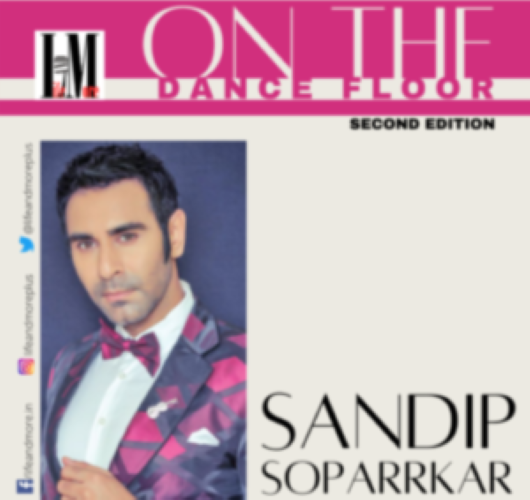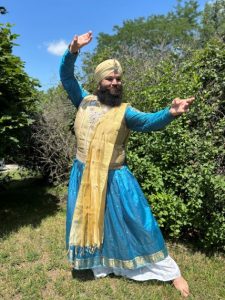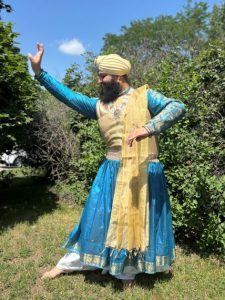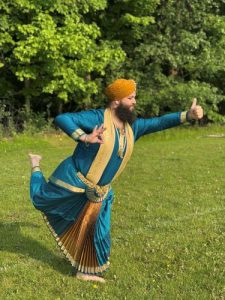Art Has No Religion: The Inspiring Journey of Asa Willoughby

A unique voice in the world of Indian classical dance, Asa Willoughby is trained in both Kathak and Bharatanatyam. Born and raised in England to a multicultural family, he began dancing as a teenager and has since studied under renowned gurus in the UK, India, and the US. As a turbaned Sikh male dancer, Asa challenges stereotypes and embraces the philosophy that art has no religion. Today, alongside pursuing a PhD in diaspora and cultural identity, he continues to perform and share his passion, inspiring audiences across borders. Excerpts from his interview:
How was your dance training?
I actually came to dance relatively late compared to many other classical dancers. My journey began when I was 14, when I first started learning Kathak, and a year later I took up Bharatanatyam at 15. Kathak has always been a special part of my life. Most of my training in the Lucknow gharana was under Anuradha Chaturvedi, founder of Drishti Dance in the UK. She herself was a senior disciple of the late Pandit Arjun Mishra, which gave me a direct link to a very strong tradition. I also spent some time training with Sujata Banerjee of the well-known Sujata Banerjee Dance Company in London.
In Bharatanatyam, I first trained in the Thanjavur style with Ananya Chatterjee at Kalakunj in England. At 18, I travelled to Kolkata to study under her guru, Smt. Thankamani Kutty, founder of Kalamandalam Kolkata. Later, after moving to the US, I began training with Marcia Madhavi Mai, an American dancer trained at Kalakshetra under Anandhi Ramachandran and Ambigai. With Madhavi’s guidance, I am now transitioning into the Kalakshetra style of Bharatanatyam.
Unlike many dancers, I do not come from a family steeped in the arts. No one in my family had ever even heard of classical Indian dance before I showed an interest. Yet, I was fortunate to have the unwavering support of my parents. My mother came with me to my first Kathak class for moral support. She later helped with my costumes and makeup. My family members attended my early performances. My brother even invited me to perform at his workplace once. Their encouragement has been invaluable in my journey.
The idea of a Sikh classical dancer is unusual. Did you face stigma?
Yes, I have faced a considerable amount of hate, particularly online. Unfortunately, many South Asians know little about other South Asian cultures, and in the Sikh community, there is a widespread belief—largely influenced by colonial-era ideas—that dancing is against the religion. I have been criticized for wearing a tilak or bindi, especially since I wear a turban, but I see this as a way to honor the sacred temple origins of Bharatanatyam and Kathak.
Tell us about your unique name and heritage?
Yes, my background is mixed. My father is English, and my mother is half Punjabi, half English. She spent her early years in Punjab before moving to England as a child. I was born and raised in England in a household that blended Punjabi and English traditions. This multicultural upbringing has shaped me deeply, allowing me to straddle different worlds, both culturally and artistically.
Being a male classical dancer in the West must be challenging. What are your thoughts?
Yes, the challenges are real. While the Indian diaspora in places like the UK and US has created opportunities, funding for the arts is limited, and sustaining a career solely through dance is difficult unless you also teach extensively.
As a male dancer, people often assume we cannot portray female characters or that we lack the grace of our female counterparts, which is not true. I also place strong emphasis on Aharyam—costume and presentation. Many male dancers opt for simple dhotis, but I almost always perform in full costume with jewellery because I believe it elevates the art form and challenges gendered expectations.
Did you face racism—both for being Sikh and for being a male classical dancer?
Most of the negativity I have faced has been online. Many within the Sikh community view classical dance as both effeminate and Hindu, which makes them uncomfortable with a turbaned Sikh wearing stage makeup. Toxic masculinity adds another layer to this resistance.
As a male student, I also faced practical challenges. Teachers often aren’t used to having male dancers, which means I had to figure out costuming and makeup on my own. It is also difficult to find teachers who adapt choreography for mixed-gender classes.
In the world of classical dance, who do you admire the most and why?
I admire those who practice their art with quiet dedication, even in small towns or isolated communities where there is little recognition. My teacher, Madhavi, is one such person—she continues her daily sadhana, not for the stage but for her love of the art.
I also admire dancers outside India who have trained entirely in the West yet devote themselves fully to their art. Names that inspire me include Jaina Modasia, Mithun Gill, Shyam Dattani, Martina Ghinetti, Tulani Kayani, and Hiten Mistry. Their commitment shows that classical Indian dance truly transcends geography and background.
What are your future plans in dance?
I am currently pursuing a PhD in the US, researching diaspora and cultural identity. I hope to integrate dance into my academic work, particularly by studying dance schools in England and the US. I have also conducted research on the Kolkata style of Bharatanatyam, which I plan to return to.
For now, I am focused on continuing my training under Madhavi and taking advantage of the performance opportunities I have in the US. I also want to challenge stereotypes about what a Kathak or Bharatanatyam dancer should look like. Dance is for all bodies, all genders, and all religions.
Sandip Soparrkar holds a doctorate in world mythology folklore from Pacific University USA, an honorary doctorate in performing arts from the National American University, He is a World Book Record holder, a well-known Ballroom dancer and a Bollywood choreographer who has been honored with three National Excellence awards, one National Achievement Award and Dada Saheb Phalke award by the Government of India. He can be contacted on sandipsoparrkar06@gmail.com





